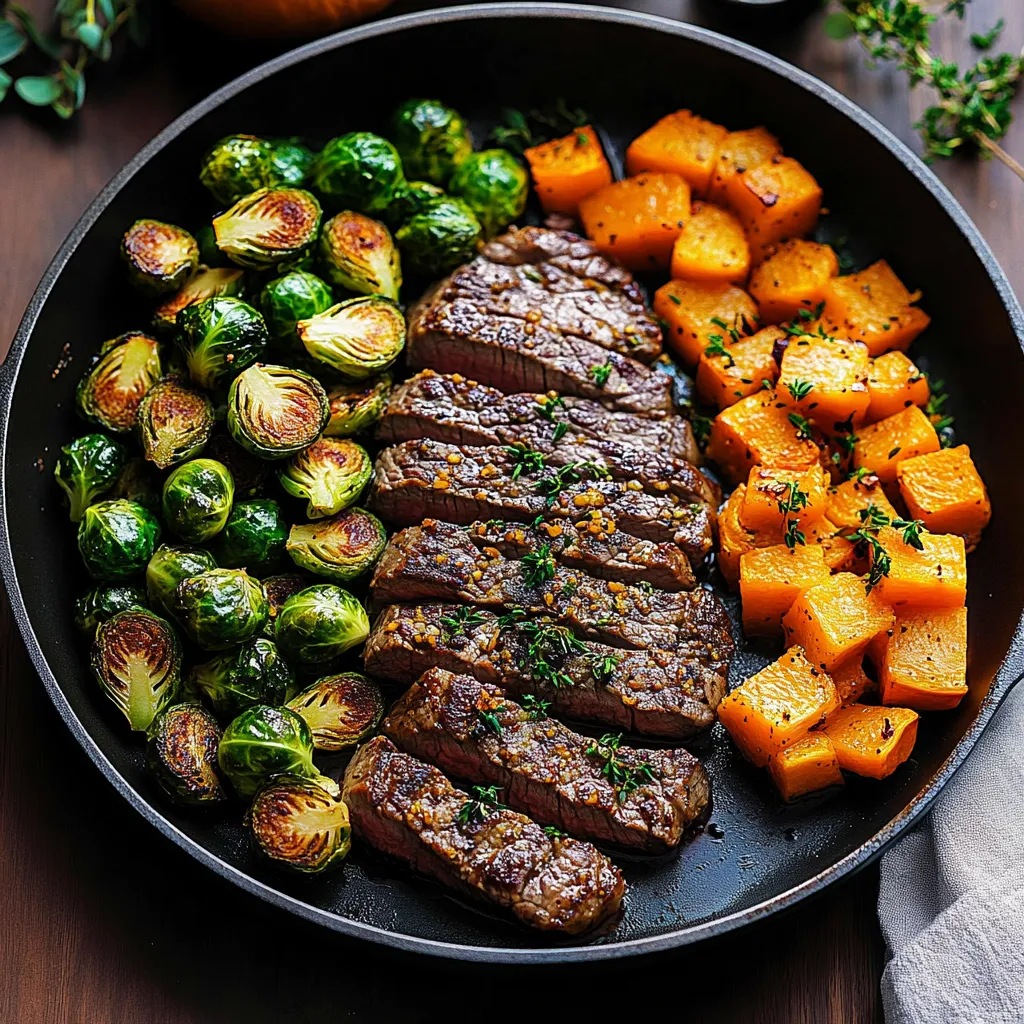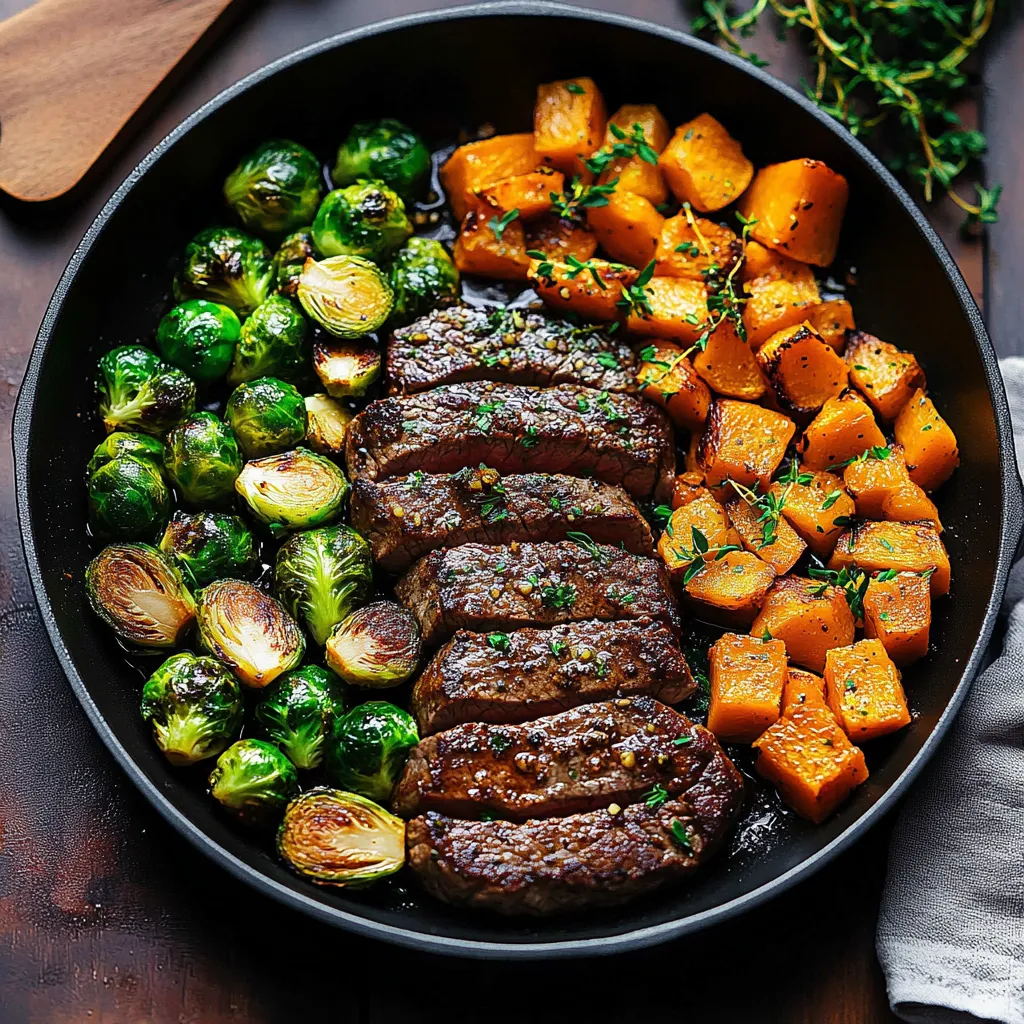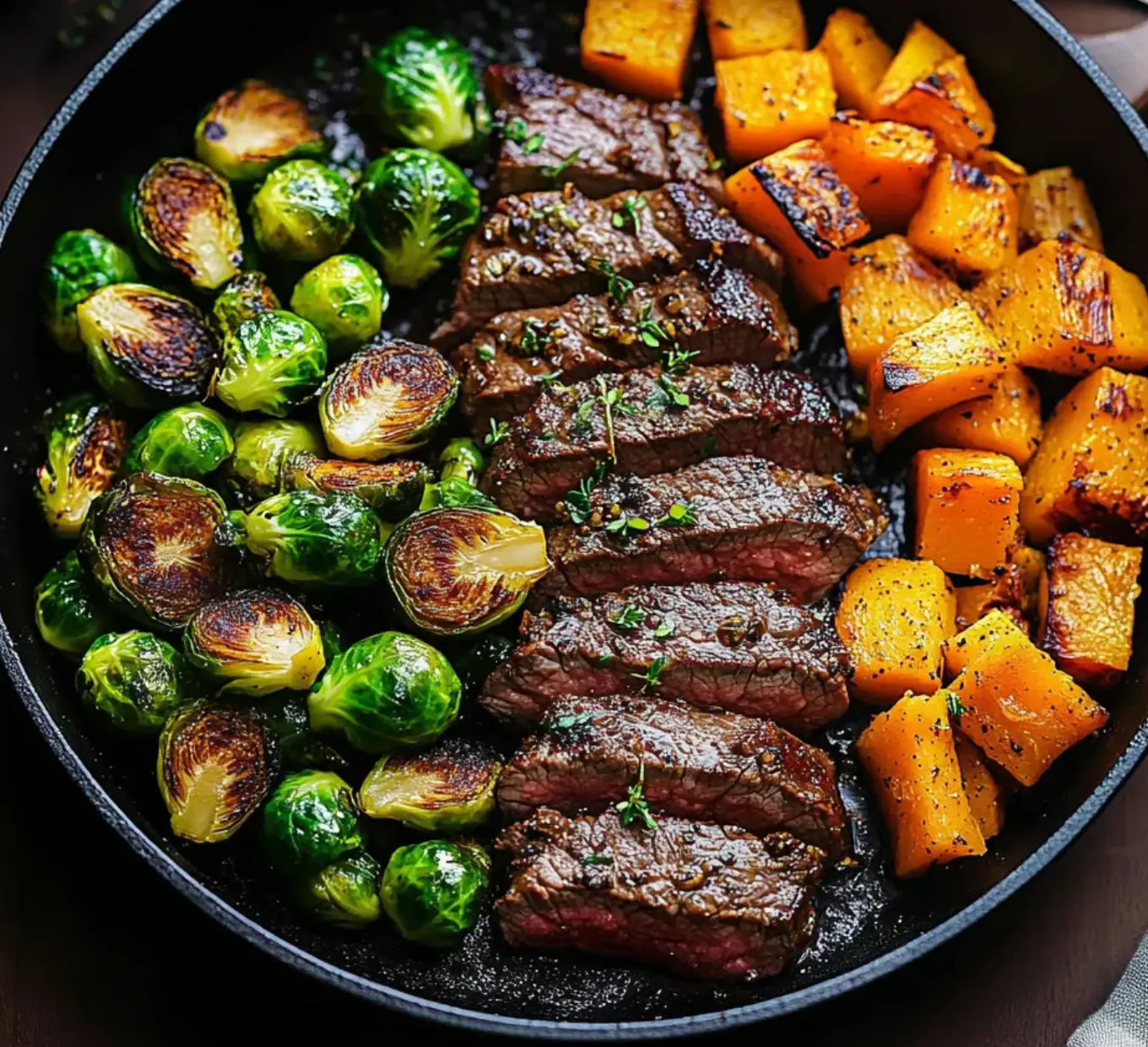 Pin it
Pin it
This garlic butter steak with Brussels sprouts and butternut squash has become my go-to dinner for impressing guests without spending all evening in the kitchen. The combination of tender steak with caramelized vegetables creates a restaurant-quality meal right at home.
I first created this recipe when trying to convert my Brussels sprout-hating husband into a fan. The caramelization from roasting combined with the savory garlic butter sauce worked magic. Now he specifically requests this dish when we have friends over.
Ingredients
- Flank steak: Choose a piece with consistent thickness for even cooking and look for good marbling
- Brussels sprouts: Select firm, bright green sprouts of similar size for even cooking time
- Butternut squash: Pick one with a matte skin free of blemishes and feels heavy for its size
- Garlic: Fresh cloves provide much better flavor than pre-minced jarred varieties
- Butter: Use unsalted so you can control the overall saltiness of the dish
- Fresh thyme: Adds an earthy dimension that dried cannot match
- Smoked paprika: Provides a subtle smokiness that enhances the beef without overpowering
- Olive oil: Use good quality extra virgin for the vegetables but any olive oil works for the steak
- Salt and pepper: Kosher salt and freshly ground black pepper make a noticeable difference
Step-by-Step Instructions
 Pin it
Pin it
- Prepare the butternut squash:
- Preheat your oven to 400°F. Toss peeled and cubed butternut squash with olive oil, salt and pepper. Spread in a single layer on a parchment-lined baking sheet. Roast for about 30 minutes until the edges begin to caramelize and the centers are tender when pierced with a fork.
- Roast the Brussels sprouts:
- While the squash is roasting, trim Brussels sprouts and cut them in half. Toss with olive oil, salt and pepper. Arrange in a single layer on a parchment-lined baking sheet. Roast at 400°F for 20-30 minutes until the edges are crispy and dark brown. The slight char is what converts Brussels sprout skeptics.
- Season the steak:
- Pat the flank steak dry with paper towels first which helps achieve a better sear. Season with smoked paprika, chili powder, salt and freshly ground black pepper on both sides. Be generous with the salt as it brings out the flavor of the beef.
- Cook the steak:
- Heat a large cast iron skillet over medium heat for 2 minutes to ensure even heating. Add olive oil and place the steak in the hot pan. Let it cook undisturbed for 5 minutes to develop a proper crust. Flip once and cook another 5 minutes for medium-rare. Use a meat thermometer for precision.
- Make the garlic butter:
- After removing the steak to rest, add butter and minced garlic to the same skillet. Cook on low-medium heat until the garlic becomes fragrant and slightly golden, about 1-2 minutes. Be careful not to burn the garlic as it will turn bitter.
- Combine and serve:
- Slice the rested steak against the grain into thin strips. Return to the skillet with the garlic butter and fresh thyme. Toss to coat. Add the roasted vegetables to warm through. Adjust seasoning with additional salt and pepper if needed.
The butternut squash is my secret favorite component of this dish. When roasted properly, it develops a caramelized exterior while maintaining a creamy interior that absorbs the garlic butter beautifully. I sometimes roast extra squash just to have leftovers for lunch the next day.
Make-Ahead Options
This recipe works wonderfully for meal prepping or entertaining. You can roast the vegetables up to 2 days ahead and store them in the refrigerator. When ready to serve, simply reheat them in the skillet with the garlic butter while the steak rests. This approach makes the final assembly incredibly quick for a weeknight dinner.
Flavor Variations
While this recipe is delicious as written, you can easily customize it to suit your preferences. Try adding a sprinkle of crushed red pepper flakes for heat, or a splash of balsamic vinegar for tanginess. Rosemary can be substituted for thyme for a more robust herb flavor. For a richer finish, add a tablespoon of heavy cream to the garlic butter sauce just before serving.
Perfect Pairings
This one-pan meal stands perfectly on its own, but if you want to round out the meal, consider serving it with a simple green salad dressed with lemon vinaigrette. For wine pairings, a medium-bodied red like Merlot or Cabernet Franc complements the savory richness of the steak and vegetables beautifully.
 Pin it
Pin it
This recipe promises to elevate simple ingredients into an unforgettable meal showcasing both flavor and technique.
Frequently Asked Questions
- → How do I know when my steak is cooked to the right temperature?
For medium-rare, use a meat thermometer to check that the internal temperature reaches 130°F in the thickest part of the steak. For medium, aim for 145°F, which is the FDA-recommended safe internal cooking temperature. Remember that the steak will continue cooking slightly after being removed from heat.
- → Why is it important to slice steak against the grain?
Slicing against the grain (perpendicular to the muscle fibers) shortens the muscle fibers, making each bite more tender and easier to chew. This is especially important for cuts like flank steak, which can be tough if cut incorrectly.
- → Can I prepare any components of this dish ahead of time?
Yes, you can roast the butternut squash and Brussels sprouts up to a day ahead and refrigerate them. Simply reheat them in the skillet with the garlic butter and steak. The steak itself is best prepared fresh for optimal tenderness and flavor.
- → What can I substitute for flank steak?
Skirt steak, hanger steak, or flat iron steak would all work well as substitutes. Each has a similar texture and takes well to quick cooking methods. Just adjust cooking times based on thickness to achieve your preferred doneness.
- → How do I prevent my garlic from burning when making the butter sauce?
Cook the garlic on low to medium-low heat for just 1-2 minutes until fragrant and softened but not browned. Using butter helps prevent burning as well. If your garlic is cooking too quickly, you can temporarily remove the pan from heat or reduce the temperature further.
- → Can I use different vegetables with this dish?
Absolutely! Sweet potatoes, carrots, cauliflower, or broccoli would all work well as substitutes. Just adjust roasting times accordingly—denser vegetables like carrots will need longer cooking times than tender ones like broccoli.
